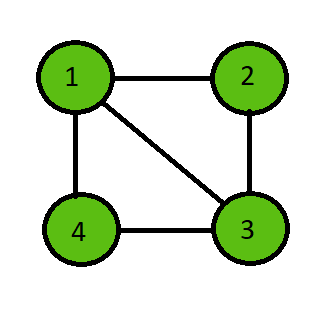实现 Vizing 定理的Java程序
图论的 Vizing 定理指出,每个简单的无向图的色指数都比图的最大度数 'd' 大 1。简单来说,该定理指出色度指数可以是 'd' 或 'd'+1。
图的色度指数是为图的边着色所需的最小颜色数,以便共享同一顶点的任何两条边具有不同的颜色。
例子:
Input:

Output:
Chromatic Index = 3
Edge from 1 to 2 : Color 1
Edge from 2 to 3 : Color 2
Edge from 3 to 4 : Color 1
Edge from 4 to 1 : Color 2
Edge from 1 to 3 : Color 3

算法:
以下是该算法的分步方法:-
- 初始化边数和边列表。
- 根据 Vizing 定理为图形着色。
- 为边指定颜色并检查相邻边是否具有相同的颜色。
- 如果任何相邻边具有相同的颜色,则增加颜色以尝试该边的下一种颜色。
- 重复直到所有边根据定理得到它的颜色。
- 完成后打印所有边缘的颜色最大值和每个边缘的颜色。
上述方法的实现:
Java
// Java program to Implement
// Vizing's Theorem
import java.util.*;
public class chromaticIndex {
// Function to find the chromatic index
public void edgeColoring(int[][] edges, int e)
{
// Initialize edge to first
// edge and color to color 1
int i = 0, color = 1;
// Repeat until all edges are done coloring
while (i < e) {
// Give the selected edge a color
edges[i][2] = color;
boolean flag = false;
// Iterate through all others edges to check
for (int j = 0; j < e; j++) {
// Ignore if same edge
if (j == i)
continue;
// Check if one vertex is similar
if ((edges[i][0] == edges[j][0])
|| (edges[i][1] == edges[j][0])
|| (edges[i][0] == edges[j][1])
|| (edges[i][1] == edges[j][1])) {
// Check if color is similar
if (edges[i][2] == edges[j][2]) {
// Increment the color by 1
color++;
flag = true;
break;
}
}
}
// If same color faced then repeat again
if (flag == true) {
continue;
}
// Or else proceed to a new vertex with color 1
color = 1;
i++;
}
// Check the maximum color from all the edge colors
int maxColor = -1;
for (i = 0; i < e; i++) {
maxColor = Math.max(maxColor, edges[i][2]);
}
// Print the chromatic index
System.out.println("Chromatic Index = " + maxColor);
for (i = 0; i < e; i++)
{
System.out.println("Edge from " + edges[i][0]
+ " to " + edges[i][1]
+ " : Color " + edges[i][2]);
}
}
// Driver code
public static void main(String[] args)
{
// Number of edges
int e = 5;
// Edge list
int[][] edges = new int[e][3];
// Initialize all edge colors to 0
for (int i = 0; i < e; i++) {
edges[i][2] = -1;
}
// Edges
edges[0][0] = 1;
edges[0][1] = 2;
edges[1][0] = 2;
edges[1][1] = 3;
edges[2][0] = 3;
edges[2][1] = 4;
edges[3][0] = 4;
edges[3][1] = 1;
edges[4][0] = 1;
edges[4][1] = 3;
// Run the function
chromaticIndex c = new chromaticIndex();
c.edgeColoring(edges, e);
}
}输出
Chromatic Index = 3
Edge from 1 to 2 : Color 1
Edge from 2 to 3 : Color 2
Edge from 3 to 4 : Color 1
Edge from 4 to 1 : Color 2
Edge from 1 to 3 : Color 3